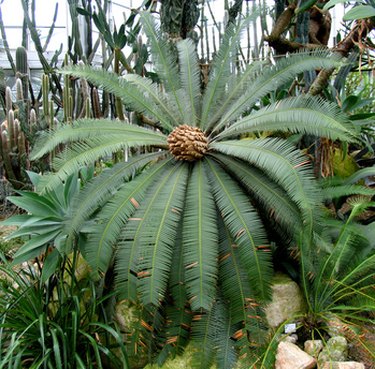
Sago palms are stately presences in the landscape. They can be grown indoors in pots or outdoors in temperate zones. Sago palms are not actually palms, but are cycads. These are ancient members of the plant family that have been on earth for millions of years with little evolutionary change. Sagos are not difficult to take care of as long as they receive sunlight and warm temperatures. They can even tolerate temperatures below 20 degrees F. Insects are the primary sago problem.
Whitefly
Video of the Day
Whitefly is such a common insect it can infest almost all plants. It is found indoors and out of doors. The insects are extremely tiny and have small wings. There are different species that prefer target plants but most whitefly insects aren't picky. Adult whitefly live out the necessary stages of life under leaves, while nymphs are stationary creatures that attach to a feeding site and stay there. Whitefly feed in plant phloem and remove sap. This reduces the vigor of that plant and can cause related health issues.
Video of the Day
White Mealy Bugs
Mealy bugs are soft-bodied insects that are covered in a white, fiberous coating. They are spotted on leaf veins or where leaves connect to the body of the plant. Mealy bugs are hard to get rid of but insecticidal soap offers some control. Feeding masses of white mealy bugs will cause leaves to turn yellow and eventually die and fall off.
Asian Cycad Scale
Asian cycad scale is an insect that has reached epic infestations in areas where sago palms are commonly grown. The bugs are covered with a hard shell that is white and fuzzy. Scale insects suck the saps and fluids from plants and can do significant damage to their health and vigor. An interesting natural remedy to the pests is coffee sprayed on the leaves and trunks of the tree. Asian cycad scale is also called white scale.
Torpedo Bug
Torpedo bug is considered a pest in tropical climates but it is just moving into areas like California. The adult is a yellow-green moth but the immature insect looks like a tiny white crayfish. They prey on crop plants primarily but can infest ornamentals. Nymphs go through five cycles before they become adults. The adult is formed to look like a leaf but has pink eyes.